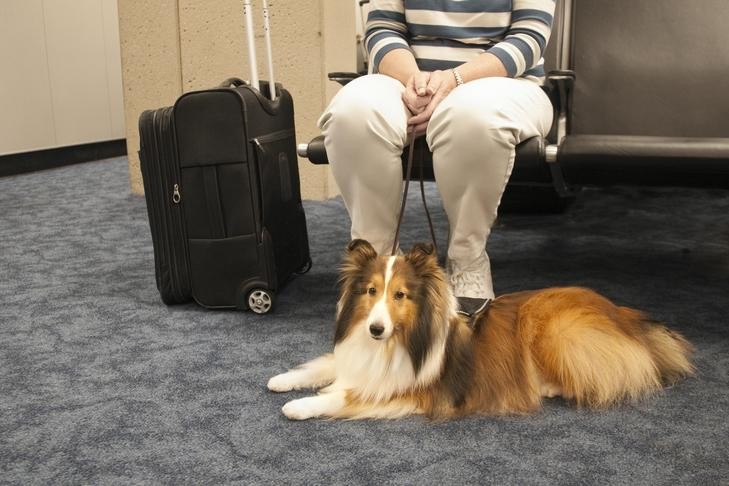Air Travel With Dogs can be a smooth experience with proper planning. SIXT.VN understands the importance of ensuring a safe and comfortable journey for your furry companions. This guide will provide you with comprehensive information and practical tips to navigate air travel with your beloved dog, including understanding airline pet policies, preparing your dog for the flight, and ensuring their well-being throughout the journey. Make your travel with your pet a pleasant experience.
1. Should You Consider Air Travel With Your Dog?
Yes, but you should consider some things first. Traveling by air can be stressful for both humans and dogs. According to Dr. Jerry Klein, Chief Veterinary Officer for the American Kennel Club, the strange sounds, sights, and smells of airports and new destinations can be challenging for pets.
- Gastrointestinal Health: Changes in diet and water can affect a dog’s gastrointestinal health.
- Dehydration: The upheaval of traveling and time-zone changes could lead to dehydration.
- Medication Schedules: Interruptions to strict medication schedules, such as insulin for diabetic dogs, could lead to potentially serious consequences.
Consulting your veterinarian before flying with your dog is crucial.
 Papillon sitting indoors with a traveling crate in the background.
Papillon sitting indoors with a traveling crate in the background.
2. What Preparations Are Needed Before Flying?
Research and preparation are essential to ensure a smooth journey when flying with your dog.
- Check Travel Restrictions: Confirm if your dog can fly to your destination and if there are any quarantine, vaccine, or other restrictions. The AKC provides a list of state-by-state travel requirements.
- Book Direct Flights: Whenever possible, book direct flights to minimize stress for your dog.
- Choose Optimal Flight Times: Travel during early morning or evening flights in the summer to avoid the hottest parts of the day, and midday flights in the winter to avoid the cold.
- CDC Guidelines: For dogs entering the U.S., the Centers for Disease Control and Prevention (CDC) have guidelines that went into effect in August 2024. The person traveling with the dog must submit a CDC-approved Dog Import Form online in advance.
Key CDC Requirements:
| Requirement | Description |
|---|---|
| Rabies Immunization | All dogs entering the U.S. must be immunized against rabies. |
| Age Requirement | Dogs must be at least 6 months old. |
| Microchip | Dogs must have an International Standards Organization (ISO) standard microchip. |
| High-Risk Country Requirements | Dogs coming from a high-risk country must have a U.S. rabies vaccine certificate, a certification of foreign-issued rabies vaccination, or a certification of foreign rabies vaccination, and a microchip form. |
| Quarantine | In some cases, dogs may need to be quarantined after arriving in the U.S. |
3. How to Prepare Your Dog: Health Checklist?
Ensuring your dog is healthy enough to travel is paramount for their well-being.
- Schedule a Veterinary Appointment: Even if a health certificate isn’t required, it’s best to have your dog examined by your veterinarian. According to the American Veterinary Medical Association (AVMA), a vet visit ensures your dog is fit for travel and up-to-date on vaccinations.
- Prepare Medications: Pack enough of any prescription medications your dog needs for the length of your trip, including flea and tick preventatives.
- Prescription Diets: If your dog eats a specialized diet, bring enough food for the trip, as it may not be available while traveling.
4. What Should You Pack for Your Dog When Flying?
Packing the right items ensures your dog’s comfort and safety during the flight.
- Proof of Vaccinations: Carry a health certificate signed by your veterinarian, even if not required.
- Airline-Approved Carrier: Ensure the carrier meets the airline’s size requirements and is waterproof.
- Portable Bowls: Pack portable water and food bowls.
- Food and Treats: Bring a small amount of food and treats in your carry-on luggage.
- Poop Bags and Pet Wipes: These are essential for easy clean-up.
- Chew Toy: A chew toy can help comfort your dog during takeoff and landing.
5. How Should You Acclimatize Your Dog to the Travel Carrier?
Familiarizing your dog with their crate is crucial for a stress-free travel experience.
- Early Exposure: Introduce your dog to their crate early, so they become comfortable with being inside for extended periods.
- Positive Reinforcement: Let your dog explore their crate at home, associating it with praise and treats. According to a study by the University of Bristol, positive reinforcement can significantly reduce anxiety in dogs.
- Desensitization: Bring your dog to loud and crowded dog-friendly places to help them get used to the sights and sounds of the airport.
6. What Happens to Dogs at the Airport?
Navigating the airport with your dog requires understanding the procedures involved.
- Cargo Check-In: If your dog is flying via cargo, check them in with the airline upon arrival.
- TSA Screening: If your dog is traveling in the cabin, they will need to come out of their carrier for security screening.
- Pet Relief Areas: Most airports offer pet relief areas for your dog to relieve themselves.
 Sealyham Terrier laying down in a travel crate.
Sealyham Terrier laying down in a travel crate.
7. How to Handle Your Dog During the Flight?
Once on the plane, your dog’s comfort and safety are paramount.
- Carrier Requirement: Dogs must remain in their carrier throughout the flight.
- Comfort Measures: Provide a chew toy to help your dog relax during turbulent parts of the flight.
- Stay Calm: Your demeanor can influence your dog’s stress levels. Remaining calm and reassuring can help them feel more secure.
8. Which Airlines Allow Air Travel With Dogs? An Airline-by-Airline Guide
Different airlines have varying policies regarding pet travel. Always contact the airline in advance to confirm their specific guidelines.
8.1. Alaska Airlines
- Health and Vaccine Requirements: Health certificates are not required for dogs in the cabin but are required for cargo. Dogs must be in good health.
- Cabin Allowance: Small dogs in approved carriers are allowed in the cabin, counting as the passenger’s carry-on.
- Cargo Allowance: Dogs must be at least 8 weeks old and weaned to fly cargo.
- Fees: $100 per pet for cabin or cargo.
8.2. American Airlines
- Health and Vaccine Requirements: Health certificates are required for dogs traveling via cargo.
- Cabin Allowance: Dogs are allowed in the cabin in approved carriers for flights up to 11 hours and 30 minutes.
- Cargo Allowance: Only active-duty US Military and US State Department personnel can transport pets as cargo.
- Fees: $150 per carrier for cabin travel.
8.3. Delta
- Health and Vaccine Requirements: Health certificates are not required for cabin travel but are required for cargo.
- Cabin Allowance: Dogs must fit in a carrier under the seat.
- Cargo Allowance: Carriers must comply with International Air Transport Association (IATA) regulations.
- Fees: $95 each way for domestic flights, $200 for international flights.
8.4. Frontier
- Health and Vaccine Requirements: No health certificates are required, but specific destinations may require them.
- Cabin Allowance: Dogs must be able to stand, turn around, and lay down in a carrier under the seat.
- Cargo Allowance: Not allowed.
- Fees: $99 each way.
8.5. Hawaiian Airlines
- Health and Vaccine Requirements: Health certificates are required for flights between Hawaii and the U.S. Mainland. Contact the Hawaii Department of Agriculture for quarantine and vaccine requirements.
- Cabin Allowance: Allowed on interisland flights and flights between the mainland and Hawaii; combined weight must be under 25 pounds.
- Cargo Allowance: Weight of pet and carrier must not exceed 70 pounds.
- Fees: $35 for flights within Hawaii, $125 for flights between Hawaii and the mainland.
8.6. JetBlue
- Health and Vaccine Requirements: Dogs must have required vaccines and documentation for the destination.
- Cabin Allowance: Dogs under 20 pounds can fly in carriers in the cabin.
- Cargo Allowance: Not allowed.
- Fees: $125 for each flight.
8.7. Southwest Airlines
- Health and Vaccine Requirements: Passengers must comply with vaccination or health certificate requirements of their destination.
- Cabin Allowance: Allowed for domestic flights only.
- Cargo Allowance: Not allowed.
- Fees: $125 per pet carrier for US Mainland flights, $35 per pet carrier between Hawaiian Islands.
8.8. Spirit
- Health and Vaccine Requirements: Health certificates are not required, except for flights to the US Virgin Islands.
- Cabin Allowance: Dogs must be at least 8 weeks old and weaned; not allowed on international flights.
- Cargo Allowance: Not allowed.
- Fees: $125 pet fee for each flight.
8.9. United
- Health and Vaccine Requirements: Health certificates are encouraged but not required for domestic flights. Required for international flights.
- Cabin Allowance: Dogs must be at least 2 months old for domestic flights and 4 months old for international flights.
- Cargo Allowance: Not allowed.
- Fees: $125 for each flight.
 Shetland Sheepdog service dog laying next to its owner at the airport.
Shetland Sheepdog service dog laying next to its owner at the airport.
9. What If Problems Arise During the Flight?
Despite careful planning, unexpected issues can occur during air travel.
- Stay Calm: Your dog will sense your stress, so remain calm and reassuring.
- Address Immediate Needs: If your dog becomes anxious or uncomfortable, offer a chew toy or familiar blanket.
- Seek Assistance: Contact a flight attendant for help with any specific issues.
10. FAQ About Air Travel with Dogs
10.1. What Size Carrier Do I Need for My Dog?
The carrier should be large enough for your dog to stand, turn around, and lie down comfortably.
10.2. Can My Dog Sit on My Lap During the Flight?
No, dogs must remain in their carrier throughout the flight.
10.3. Are There Breed Restrictions for Air Travel?
Some airlines have breed restrictions due to safety concerns. Check with your airline for specific policies.
10.4. What If My Dog Gets Motion Sickness?
Consult your vet for medications to help with motion sickness.
10.5. How Early Should I Arrive at the Airport When Flying with My Dog?
Arrive at least 2-3 hours before your flight to allow ample time for check-in and security procedures.
10.6. Can I Sedate My Dog for the Flight?
Sedating your dog is generally not recommended unless advised by your vet. Sedatives can affect a dog’s breathing and heart rate at high altitudes.
10.7. What Documents Do I Need to Fly with My Dog Internationally?
You will likely need a health certificate, proof of rabies vaccination, and possibly an import permit.
10.8. How Do I Find Pet Relief Areas at the Airport?
Most airports have designated pet relief areas. Check the airport’s website or ask an airport employee for directions.
10.9. What Should I Do If My Flight Is Delayed?
Ensure your dog has access to water and a chance to relieve themselves. Keep them as comfortable as possible in their carrier.
10.10. Can I Bring My Dog as an Emotional Support Animal?
As of 2021, emotional support animals are considered pets and are not permitted to fly freely in the cabin unless they are in a carrier.
Flying with your dog requires careful planning and consideration. By following these guidelines, you can ensure a safe, comfortable, and stress-free journey for both you and your furry friend. Remember to always check with your airline for their specific policies and requirements.
Planning a trip to Vietnam with your dog? Let SIXT.VN assist you in making all the necessary arrangements. From airport transfers to pet-friendly accommodations, SIXT.VN ensures a seamless and enjoyable travel experience for you and your beloved companion. Contact us today at Hotline/Whatsapp: +84 986 244 358 or visit our website at SIXT.VN for more information. Address: 260 Cau Giay, Hanoi, Vietnam.



